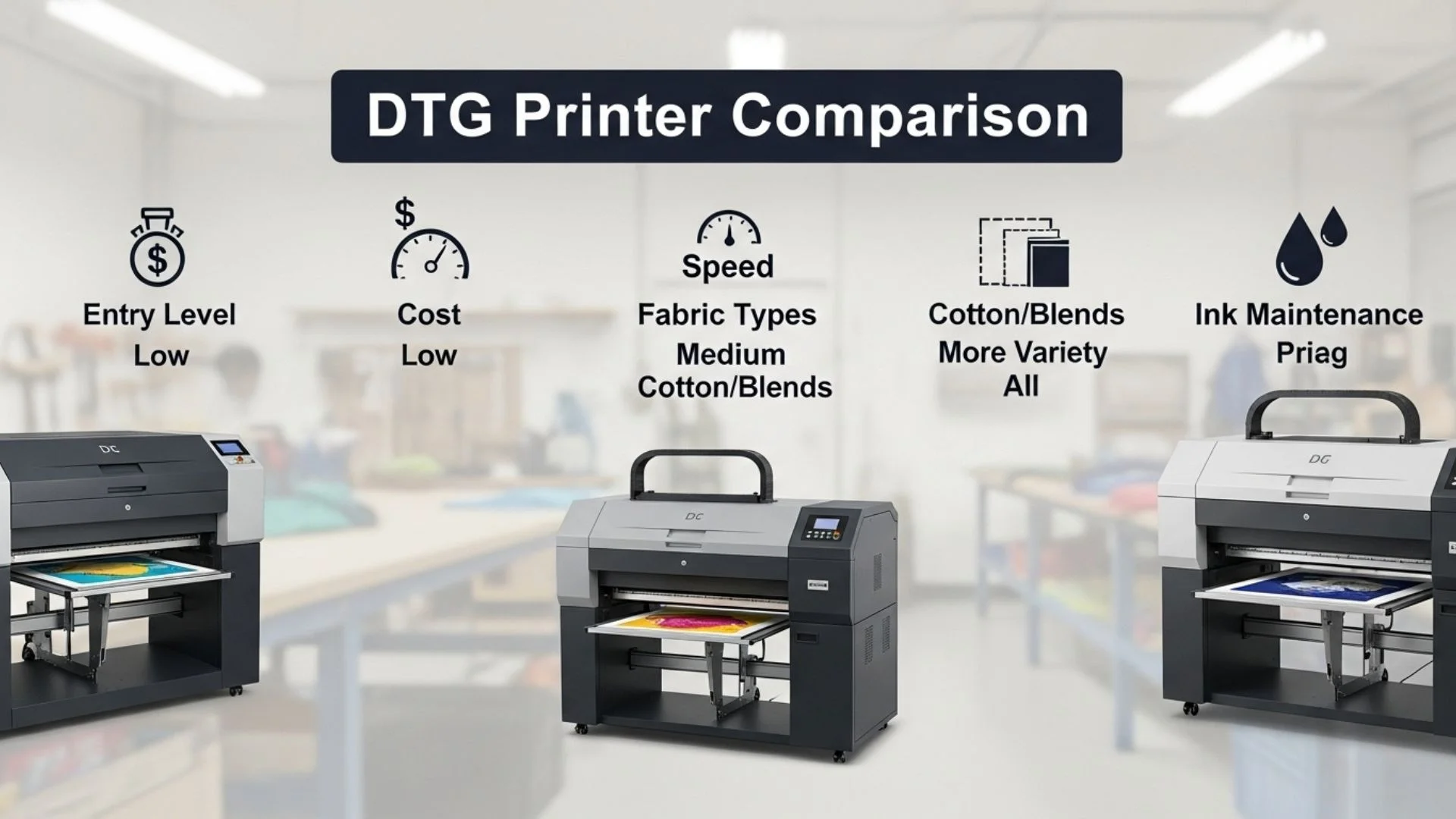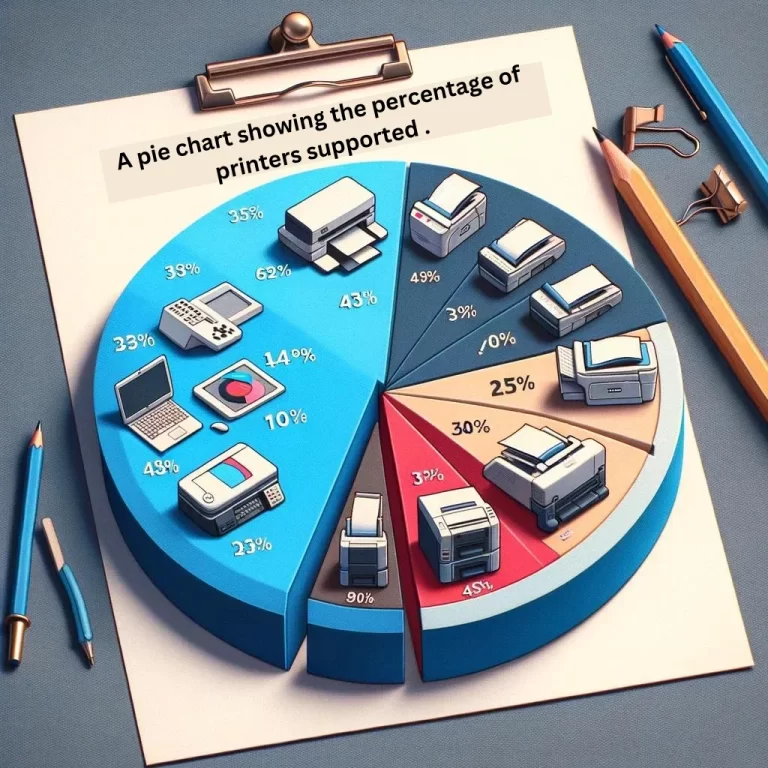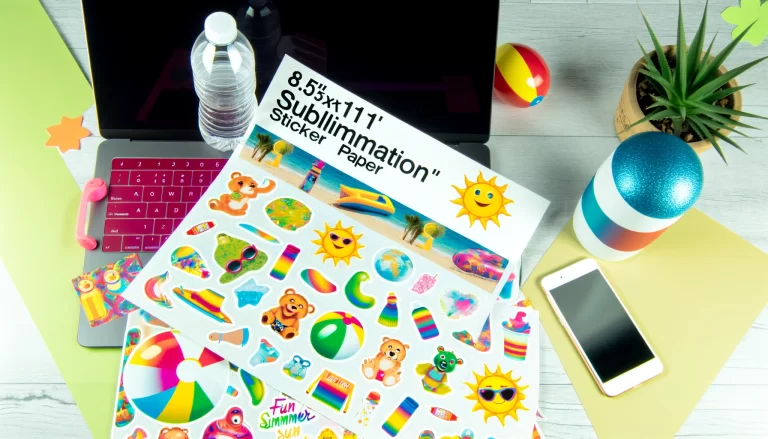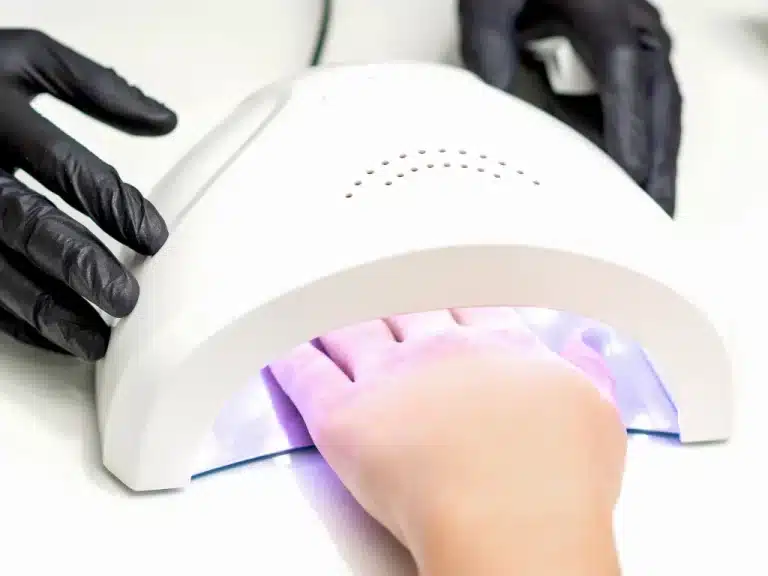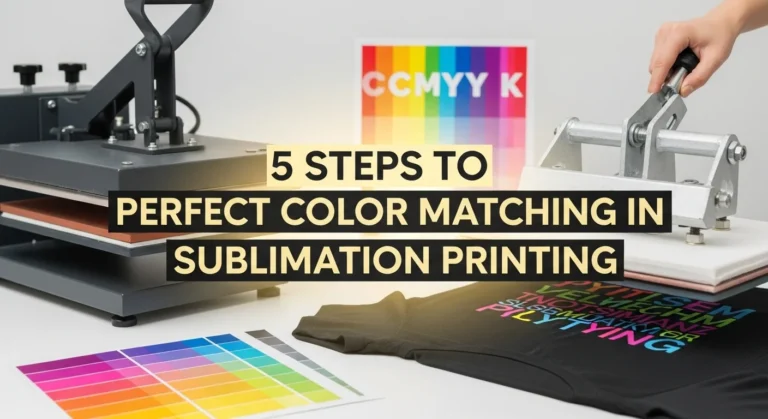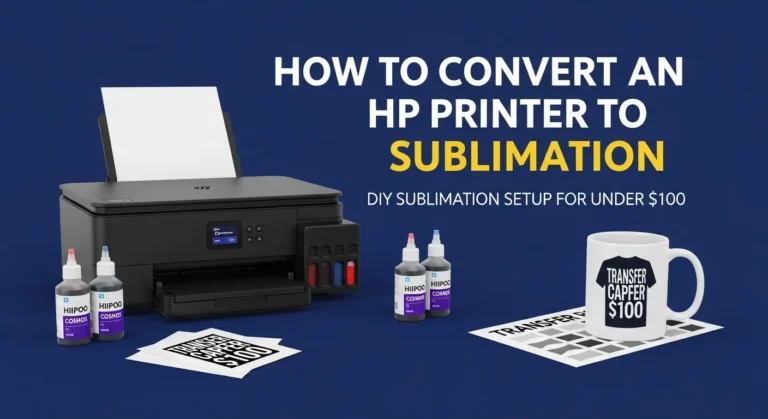DTG Printer Comparison:
Picking the right DTG printer? Epson F2100 shines for reliable cotton prints on a budget, around $12k, but it’s slower at 20-30 shirts/hour.
Brother GTX Pro speeds things up to 60-100/hour for mid-volume shops, though it costs $19k and needs space.
Ricoh Ri 1000 eases in newbies with compact designs under $15k, limited to smaller platens.
Kornit Breeze/Atlas automates high-volume runs but hits $50k+, ideal for pros. Match your needs to volume and cost.
I’ll cover the main models people are buying in 2025, what they’re best at, how much they typically cost by tier, and a compact comparison chart you can skim. You’ll also get practical tips on choosing for home use, beginners, t-shirts only, or a small business.
What matters when comparing DTG printers, fast
- Print quality and white ink handling, for vibrant prints on dark shirts.
- Throughput, how many shirts per hour you need.
- Operating costs, especially ink and pretreat chemicals.
- Maintenance and uptime, how often you need to clean or replace parts.
- Space and power needs, some machines are large and need dedicated ventilation.
- Support and parts, local dealer support matters for uptime.
If you’re working on darker garments, don’t miss our DTG printing on a black shirt guide for pretreat tips and vibrant color results.
Top models at a glance (direct highlights)
- Epson SureColor F2100: reliable, consistent, great midrange choice for cotton tees.
- Brother GTX Pro: built for speed and high color fidelity, good for scaling volume.
- Ricoh Ri 1000 (Ri series): compact, beginner friendly, good entry option for small shops.
- Kornit Breeze / Kornit Atlas: integrated pretreat and enterprise features for higher throughput or fully automated workflows.
DTG printer comparison chart (quick reference)
| Model | Best for | Typical price tier | Standout strength | Common drawback |
|---|---|---|---|---|
| Epson SureColor F2100 | Small shops, consistent quality | Midrange ($7k–$15k tier typical) | Reliable prints, widely used, good support. | Not the absolute fastest for high volume |
| Brother GTX Pro | High throughput shops | Professional ($15k–$30k+) | Fast, large print area, built for production. | Higher upfront cost, larger footprint |
| Ricoh Ri 1000 | Beginners, small businesses | Entry to low-mid ($3k–$10k range) | Compact, easy to use, good color. | Smaller platen sizes, less industrial |
| Kornit Breeze / Atlas | On demand + integrated pretreat | Professional / Industrial | Integrated pretreat, built for scale and automation. | High capital cost, bigger footprint |
DTG pricing tiers in 2025 typically run from about $3,000 for basic entry models, $7,000–$15,000 for reliable midrange machines, and $15,000+ for production/industrial solutions. Use those tiers to set expectations.
Model By Model Pros & Cons
1. Epson SureColor F2100
People grab this one because it’s like that reliable buddy who shows up every time, super dependable for everyday cotton jobs, spits out killer colors that pop without much fuss, and Epson’s got parts and support everywhere, so you’re not stranded if something glitches.
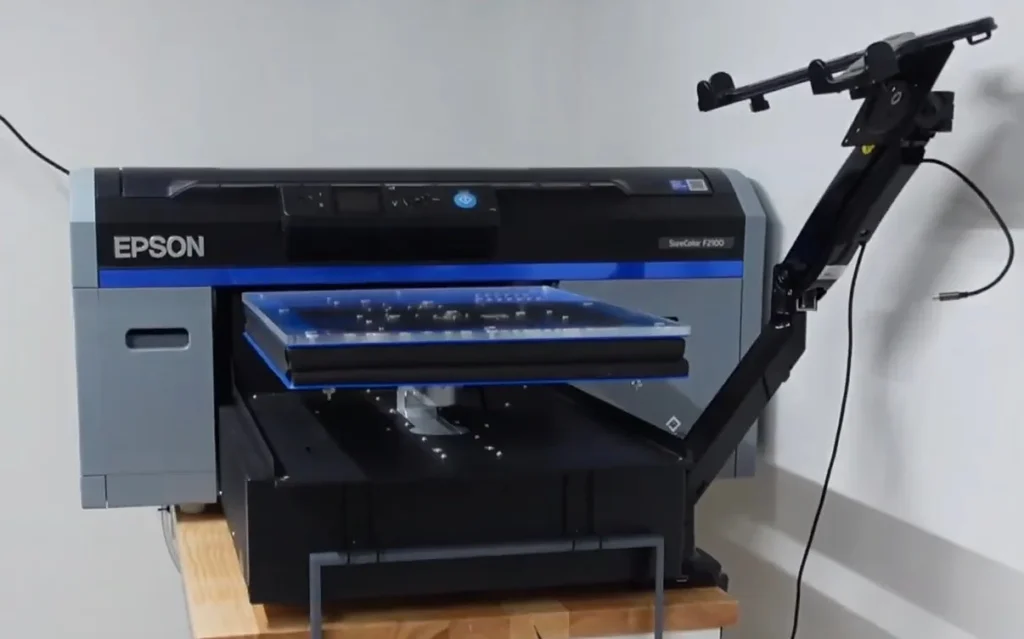
Pros
- Solid color, reliable daily use.
- Good balance of cost and output.
Cons - Not as fast as some production models.
- Requires correct pretreat for dark garments.
Curious how Epson stacks up long-term? Check out our full Epson DTG printers guide for detailed specs and real-world use cases.
2. Brother GTX Pro
This bad boy pulls in buyers chasing that rush of speed and punchy colors, especially if you’re scaling up to handle more orders without sweating the details. It’s built tough for shops that need steady throughput, like pumping out custom runs fast.
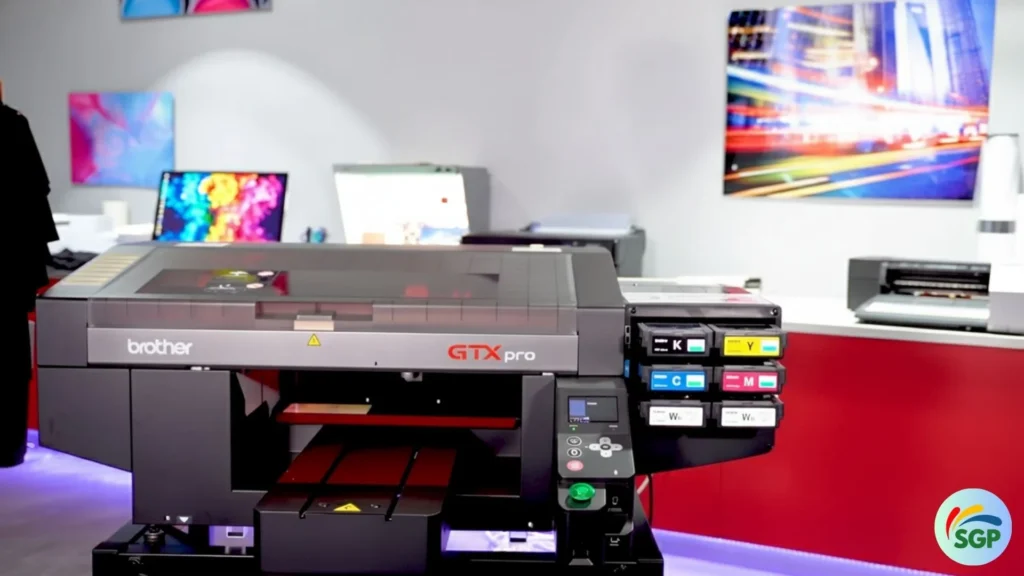
Pros
- Very fast prints per hour.
- Large platen sizes, handles thicker items.
Cons - Higher upfront cost.
- More space and power required.
3. Ricoh Ri 1000 series
New folks flock to this because it’s chill to learn on compact, not overwhelming, and feels like a gentle intro to DTG without the steep cliff. Great for solo ops or small crews testing waters on detailed, smaller-scale prints.
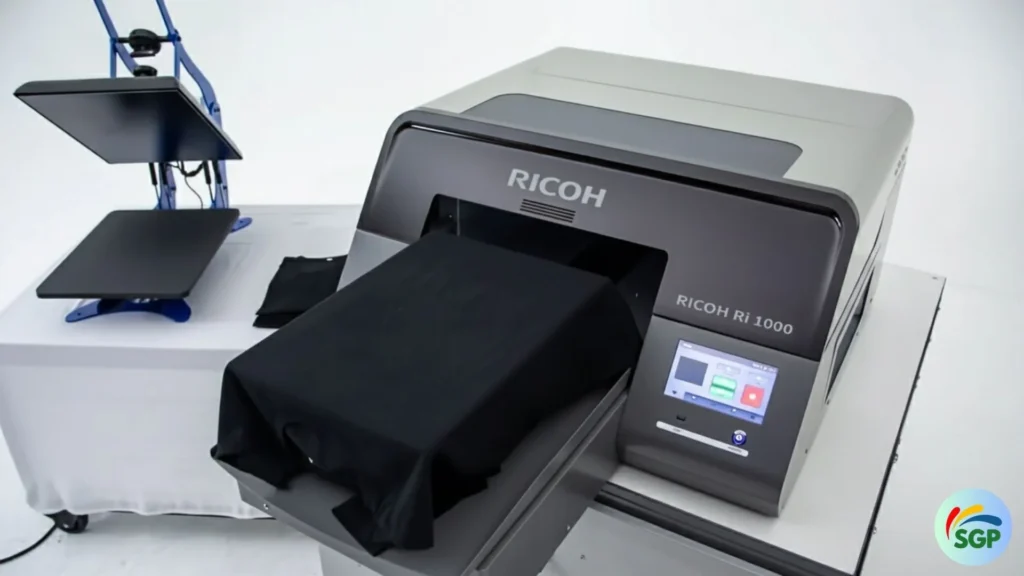
Pros
- Easier learning curve.
- Good image detail for smaller shops.
Cons - Smaller platens limit large prints.
- Fewer enterprise features.
4. Kornit Breeze / Kornit Atlas
These draw in ops ready for hands-off magic, integrated pretreatment skips messy steps, ideal for on-demand bursts without constant babysitting. Breeze leans smaller-scale, Atlas is the beast for volume kings.
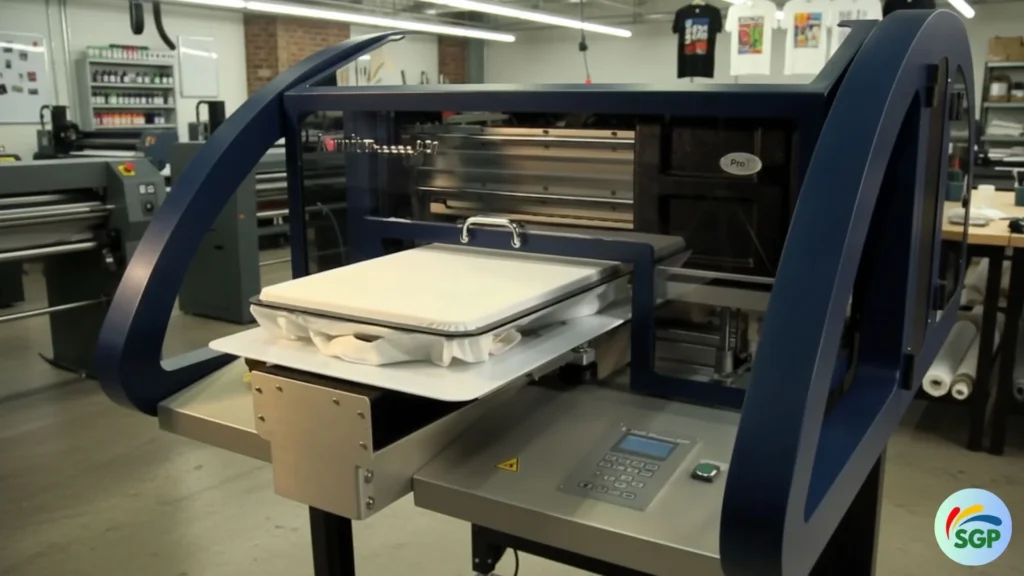
Pros
- Integrated pretreatment means fewer steps.
- Built for higher volume and reliability.
Cons - Expensive to buy and run.
- Best suited to businesses printing a lot.
Quick side-by-side to tie it up, prices are ballparks, speeds vary by job, but this should help you eyeball the fit.
| Model | Price Range | Speed (Shirts/Hr) | Max Print Area | Best For | Key Pro | Key Con |
|---|---|---|---|---|---|---|
| Epson F2100 | ~$12k | 20-30 | 16×21 in | Everyday cotton shops | Reliable colors, compact | Slower, pretreat picky |
| Brother GTX Pro | ~$19k | 60-100 | 20×28 in | Mid-volume custom runs | Fast, versatile platens | Space-hungry, costly start |
| Ricoh Ri 1000 | ~$15k | 30-50 | 14×16 in | Newbie/small detail work | Easy to learn, affordable | Small sizes, clog risks |
| Kornit Breeze/Atlas | $50k-$600k | 40-200+ | 13×19 / 23×35 in | High-volume production | Automated, multi-fabric | Expensive run, service waits |
Not sure if DTG is the right method? Our DTG vs screen printing comparison lays out the pros, cons, and real-world costs side by side.
How to pick the right DTG printer
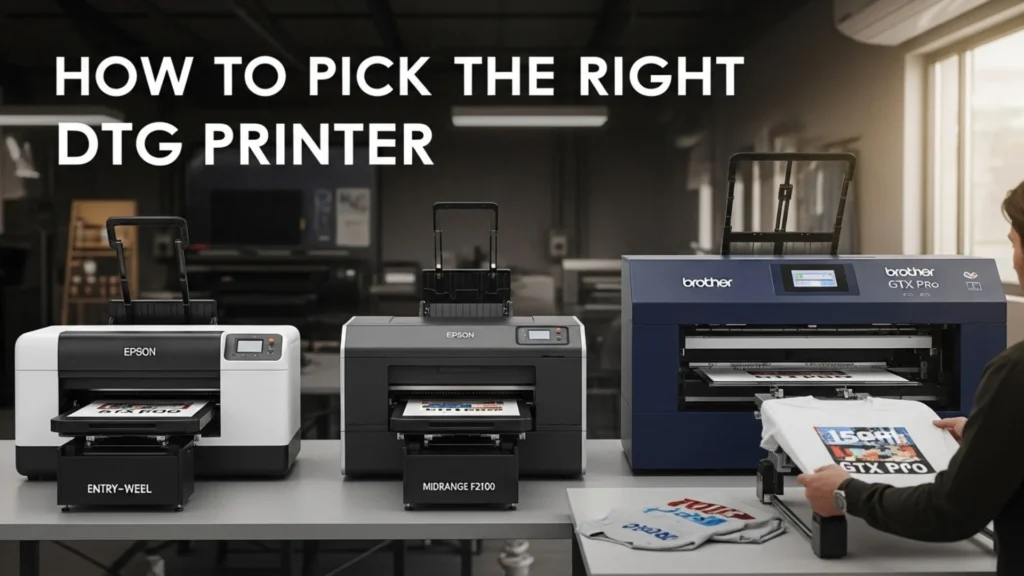
Step 1, define your monthly volume
- Under 100 shirts a month, aim for entry or mid models.
- 100–500, midrange like Epson F2100 or Ricoh.
- 500+, consider Brother GTX Pro or Kornit for production.
Step 2, check fabric and product mix
- DTG works best on high cotton content.
- If you plan lots of blends, test samples first, or consider DTF/hybrid systems.
Step 3, factor running costs
- White ink and pretreat are the biggest ongoing costs.
- Ask suppliers for real cost-per-print samples.
Step 4, plan for space and support
- Production models need more floor space and possibly installation.
- Local dealer support reduces downtime.
Step 5, test prints before you buy
- Ask vendors for sample prints on your fabrics, and for a demo of maintenance tasks.
Use-case quick picks
- Best DTG printer for home use — small entry models or compact Ricoh setups, if you’ve got a well-ventilated corner and low volume.
- Best DTG printer for beginners — Ricoh Ri series, because it’s compact and more forgiving.
- Best DTG printer for t-shirts — Epson F2100 for balanced quality and cost for cotton tees.
- Best DTG printer under $5,000 — true DTG printing under $5k are rare in 2025, most genuine DTG units start above $3k and solid used/entry options cluster around the $3k–$7k band. Expect tradeoffs in reliability and support.
- Best DTG printer for small business — Epson F2100 or small Brother units, depending on desired throughput.
- Best DTG printer 2025 — there’s no single best, pick by volume and fabric needs, but Epson and Brother remain top sellers in their segments.
Common misconceptions cleared
- DTG is only for white shirts, false. You can print on dark garments with white underbase, but pretreat and white ink management matter.
- Higher price always means better color, not always. Higher price often buys speed, automation, and lower cost per print at scale.
- DTG works on any fabric, not true. Natural fibers like cotton take DTG best, blends and synthetics need testing.
Final checklist before you buy
- Get printed samples on your exact garments.
- Compare quoted cost-per-print including ink and pretreat.
- Confirm warranty and local support.
- Consider used machines if budget is tight, but verify maintenance history.
- Plan for a small learning curve, proper ventilation, and stable workflow.
